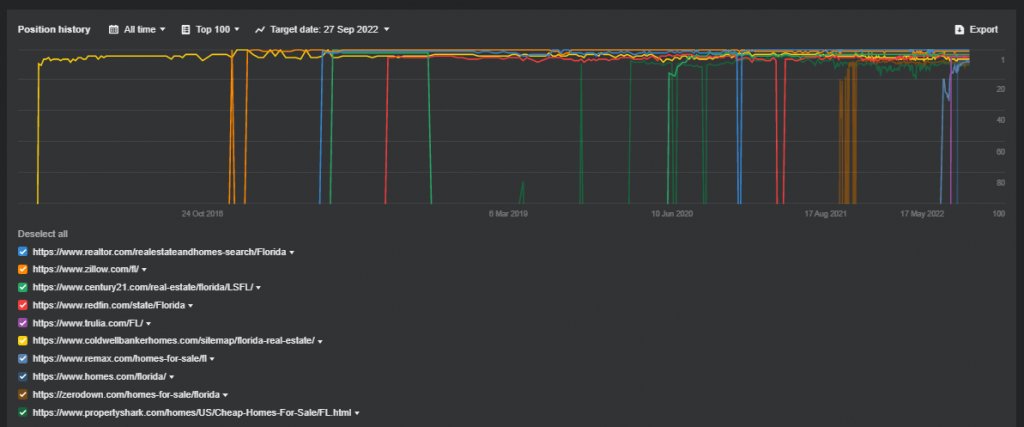Calculating Link Building ROI: Measuring SEO
Link Building is often portrayed in the wrong light. While many think of it as just another marketing campaign designed to bring traffic, it’s important that you think of it more like an investment. One of the key reasons why it doesn’t look like an investment is the difficulty in calculating Link Building ROI. In fact, you’ll be surprised to learn how much link building resembles investing in real estate.
Even the calculation of ROI for Link Building is similar to the property you own.
Fundamentally, there is only one true way to analyze the returns of your Link Building. Domain Value. But before you go on to calculating ROI, it’s important to know that you’re doing Link Building with the right goals.
Goals behind Link Building
The two main goals behind Link Building are:
- Increase in Website SERP visibility: Now, this one is rather simple. You type your keyword on Google and press “Enter”. If you see your website in the top 10 results, awesome! Or, you can log on to your SEO tools like Ahrefs or SEMrush and run your domain to learn which keywords your website is ranking in search results. Of course, the reason behind ranking on your focus keywords is likely Link Building.
- Increase in Revenue: Now, this one gets a bit tricky. Link building is not the sole reason behind your revenue. This is why calculating the impact of Link Building in terms of Revenue can be quite a daunting process.
Fortunately, you’ve stumbled on the right blog, as by the end of this article, calculating Link Building ROI will become a breeze.
Why is Link Building ROI a hassle?
The main reason why you cannot associate link building with revenue directly is that there are many other variables involved. The success of link building is attributed directly to SEO, which means that your website starts appearing in search results for customers, resulting in more orders.
However, this does not happen overnight, in fact, it may take approximately a year to actually learn the true ROI behind Link Building. In some cases, the results may take even longer to become apparent.
No worries, we’ll tell you how link building can be calculated in the short and long term. But before that, it’s important that you set up your calculation methods so everything looks right in retrospect.
Link Building: A Real Example
Remember how we said link building is like real estate? Let’s expand on that example. Your visibility on the SERPs would become your property value. Your revenue stream would be the earnings you get with your website.
Simple enough, isn’t it? We turned the link building into a literal building. Now that building needs to look the best for the best earnings. For that, you need to renovate it and add a few floors, which would require a budget.
Each new floor would mean more earnings while you keep on renovating for existing tenants too. However, adding floors will take time and resources. Moreover, tenants won’t move in immediately, so you will have to market out and wait.
But all this will be for naught if your property isn’t the talk of the town. Hence, the more popular your building is, the more people will visit it. This obviously is the traffic you need. Also, your future tenants will be among these visitors, so you have to look out.
Setting Up Calculation Methods
Luckily, your Pal Google Analytics is there to help you track these visitors and buyers. Via Google Analytics, you can check traffic spikes and even which of your web pages/floors are getting more visitors.
All you now need to do is generate UTM codes per campaign to know how your visitors are finding you. While your SEO manager might be better at explaining to you what UTM codes are, for now, think of them as the friends with whose reference your visitor reaches you.
You get a call, “Hey, this is your prospective customer, Your friend, UTM Code 1, brought me to your place.”
With Google Analytics, you can place UTM codes on specific campaigns to learn how traffic trickles down to your website. It might come from your social media page, Google, or even through an external website link.
Another component of the calculation is that you will need to keep track of your conversions per visit.
Conversion Ratio = Conversion/Visits
How many visitors converted?
Let’s be honest here: not every visitor will convert, which means achieving 1 in this equation is next to impossible. But this would also mean a small increase in the ratio would indicate that you’re going in the right direction.
Although this ratio isn’t restricted to just SEO or Link Building, it helps provide how well you’re doing overall. That SEO tool subscription will also play an important role in letting you discover the worth of your website/property.
Ahref calls it Domain Rating, and Moz calls it Domain Authority. We just prefer it as Domain Value. While not officially recognized by Google, these metrics let you know how well your website ranks in searches. 100 is the highest number for this metric. Websites with 70 or 80+ Domain Value are usually market leaders, appearing in the top results of their target keywords.
However, there are also other metrics you consider for SEO.
Yet, link building is agreeably one of, if not the most important, factors for your website’s SEO and domain value. But each link you get is not equal.
Links Assessment
You must already be aware of Do-follow and No-follow links, but link quality goes deeper than just the “rel” attribute. These four core standards can help you assess a link:
- Relevance: The backlink guiding a user to your webpage should be relevant to your niche. If it is a blog, the topic should revolve around your product or a solution you provide.
- Uniqueness: The harder a link is in acquisition, the more likely it is unique. If all your competitors are present on a backlink, then your presence there won’t be unique.
- Traffic: The amount of traffic from a backlink makes a major difference. More traffic (if relevant) often means more conversions.
- Authority: The Domain Rating or Domain Authority tells how well that website looks from the SERP perspective. Websites ranking on the first page are the ones with the highest Domain Authority.
After assessing a link on these four standards, you will know whether an acquired link will actually prove beneficial or not. Now, we turn to the formula for Link Building ROI.
The Simplest Formula For Calculating Link Building ROI
The formula for Link Building ROI is quite simple:
Link Building ROI = Net Return on Link Building / Cost of Link Building
However, this formula is easier to write than applied. As usual, the major problem is finding out the actual returns on link building, as we noted above.
You can make use of the Monte Carlo Simulation to set your aims for your Link Building Campaign. While this simulation will only provide you with estimates, so take them with a grain of salt. Ceteris Paribus also applies here. As many variables are beyond control, you better keep them all constant. However, the first thing that comes under your control is your target keyword.
In the following example, we’ll consider “Real Estate in Florida” as our target keyword.
Step 1:
Analyze the keyword and determine which website (probably a direct competitor) is ranking highest for it.
As of September 27th, 2022, the top-ranking result is https://www.realtor.com/realestateandhomes-search/Florida, making Realtor our direct competitor.
Step 2:
Use either Ahrefs or any other SEO tool to gather that competitor’s organic traffic data. From our search, we see that Realtor has 43.4 million organic traffic.
Step 3:
Use your SEO tool to learn about the Domain Rating or Authority of the website. You can consider all other metrics that may seem relevant for your own website, too, such as paid keywords.
Step 4:
Gather the same Metrics for your own website.
Step 5:
Measure the gap between the metrics of your website and that of your competitors. The resulting difference is the effort you need for your Link Building Campaign.
The idea is to close this gap as much as possible within the scope of your campaign. The more successful your link-building campaign, the closer the gap will be. You might even start leading on these metrics in the coming years if you keep your campaigns consistent.
Realtors only rose up as a leader in our mentioned keyword as of February 2021. The following metrics on the keyword “Real Estate in Florida” provide a good perspective.
Ahrefs shows that Realtor only started ranking for this keyword in 2017. Even then, it took till Feb 2021 for Realtor to reach the first position.
This isn’t to discourage you from your target keywords but instead to reiterate that link building takes time but also yields results.
Short and Long-term Methods of Calculating Link Building ROI
Now you know which keyword to have as your prime target and the gap you want to close. The ideal way to begin Link Building is to create a piece of content, publish it, and get links to that webpage. Your main targeted keyword should be utilized in that content, along with other variations.
After your Link Building campaign starts, you should get a healthy number of backlinks to your recently published content. After about 90 days, you should be able to calculate Link Building ROI for the short term.
Short-term Link Building ROI
The easiest method would be to check the increase in your Domain Authority, as that would indicate the positive impact you had thanks to new backlinks. You can also measure the difference between the traffic you got before link building and now. Similarly, your position should also have improved on the SERPs.
While you will get traffic metrics from your UTM set in Google Analytics, your SERPs position should show up against your target keyword in Ahrefs. These metrics should let you know whether you’re heading in the right direction or not.
However, even while we use the term calculation, your Link Building campaign is still in its infancy so these results can also be deemed as mere estimates.
Long Term Link Building ROI
Typically, Long-term ROI calculations should be done after about a year. Here, you will be looking at three aspects to monitor success:
- Change in Domain Authority (DA)
- Backlinks Growth over time
- Monitoring Massive Link Spikes or short durations with massive backlink fluctuations.
Long-term duration typically starts after 7 months, but it’s best to check after about a year of link building.
Your change in DA should reflect a significant change now, at least compared to the one you found during the short term. Secondly, you should have acquired some high-quality links for your webpage by now.
Monitoring Massive Link Spikes go into a bit more detail. Here, you analyze instances when you get a large number of backlinks in a short time frame. These can be good and bad for your webpage. If most of these links turned out to be toxic, then you might have been affected by negative SEO, and it’s best to remove them ASAP.
If the acquired links were legit, you should also have noticed higher traffic during that specific time period.
Now, it’s time to see how you benefitted from those previous calculations. In essence, you should know:
- How many links were acquired
- The conversion per traffic ratio
- How many visits and unique visitors do you get on average
Consistent Vigilance for Link Building
While one might feel that the above things were enough to paint a pretty accurate picture of your Link Building ROI, you can refine it even further with the following processes set in a routine.
- Consistently checking Google Analytics: See where your audience is finding you and prioritize that approach.
- Monitoring the quality of acquired links: This would help you eliminate any toxic links or even questionable ones.
- Checking Anchor text: Make sure that it is relevant in every backlink
- Monitoring brand mentions and Social Shares: It would help you maintain your social presence and also help present other backlinking opportunities.
- Bounce Rate: It will help you pinpoint if there are any factors on your webpage that might be hindering conversions.
Conclusion
Getting links is only a single phase of a successful Link Building campaign. Masters of SEO are well aware that it is a holistic approach that ensures a higher SERP ranking for a website. This is why Link Building ROI is a topic that often stays within SEO circles, as translating it to a businessman can become complicated. However, we believe that with this article, both the importance of Link Building and its ROI have become apparent to you.
Make use of this knowledge, and feel free to spread it further by sharing. Good Luck and Happy Linking!












